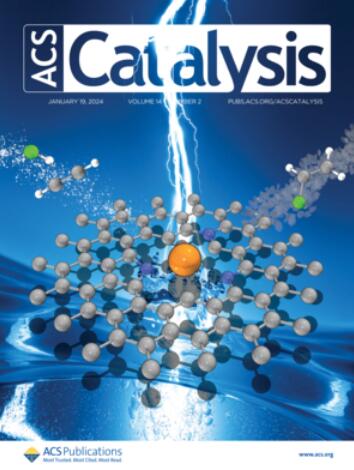A Minimal Mutation Trajectory Separates Inverting and Retaining Mechanisms on the Same Sialidase Structural Scaffold
IF 11.3
1区 化学
Q1 CHEMISTRY, PHYSICAL
引用次数: 0
Abstract
The recently discovered sialidase AmGH181 from the human gut symbiont Akkermansia muciniphila is remarkably selective to the sialyl T-antigen, a glycan found on mucins and cancer cells. However, the molecular basis for specificity and catalytic mechanism remains unknown in this enzyme family. Combining mutagenesis, X-ray crystallography, and QM/MM metadynamics, we show that specificity is governed by a flexible tryptophan–histidine pair, forming a “sugar tang” that precisely positions the sialyl T-antigen for catalysis. Hydrolysis of the sialyl-T antigen proceeds via a single-step SN2 reaction and a 3,6B/3SO → [3,6B]‡ → 3,6B/3SO → 2C5 conformational itinerary of the sialyl unit at subsite –1, resulting in the inversion of anomeric configuration. Remarkably, we altered the reaction stereochemistry by a double mutation, introducing a tyrosine to perform nucleophilic attack on the C2 of the sialyl unit at subsite –1, assisted by acid catalysis to promote aglycone departure. This retaining mutant acquired trans-sialidase activity and performed synthesis of 3′-sialyllactose in remarkably high yields. These findings suggest that the evolutionary divergence of retaining and inverting sialidases hinges on minimal active site mutations. The successful conversion of an inverting hydrolase into a retaining one provides an innovative strategy for harnessing inverting glycosidases for oligosaccharide synthesis via transglycosylation reactions.

在相同唾液酸酶结构支架上分离反转和保留机制的最小突变轨迹
最近发现的唾液酸酶AmGH181来自人类肠道共生体嗜粘菌Akkermansia muciniphila,它对黏液t抗原(黏液蛋白和癌细胞上发现的一种聚糖)具有显著的选择性。然而,该酶家族特异性的分子基础和催化机制尚不清楚。结合诱变、x射线晶体学和QM/MM元动力学,我们发现特异性是由一个灵活的色氨酸-组氨酸对控制的,形成一个“糖汤”,精确地定位唾液t抗原进行催化。sialyl- t抗原的水解通过一步SN2反应和sialyl -1亚位单元的3,6b /3SO→[3,6b]‡→3,6b /3SO→2C5构象行程进行,导致异位构型反转。值得注意的是,我们通过双突变改变了反应的立体化学,在-1亚位上引入酪氨酸对硅基单元的C2进行亲核攻击,并在酸催化的帮助下促进苷元的离开。这种保留突变体获得了反式唾液酸酶活性,并以非常高的产量合成了3 ' -唾液酸乳糖。这些发现表明,保留和逆转唾液酸酶的进化差异取决于最小的活性位点突变。倒置水解酶成功转化为保留酶,为利用倒置糖苷酶通过转糖基化反应合成低聚糖提供了一种创新的策略。
本文章由计算机程序翻译,如有差异,请以英文原文为准。
求助全文
约1分钟内获得全文
求助全文
来源期刊

ACS Catalysis
CHEMISTRY, PHYSICAL-
CiteScore
20.80
自引率
6.20%
发文量
1253
审稿时长
1.5 months
期刊介绍:
ACS Catalysis is an esteemed journal that publishes original research in the fields of heterogeneous catalysis, molecular catalysis, and biocatalysis. It offers broad coverage across diverse areas such as life sciences, organometallics and synthesis, photochemistry and electrochemistry, drug discovery and synthesis, materials science, environmental protection, polymer discovery and synthesis, and energy and fuels.
The scope of the journal is to showcase innovative work in various aspects of catalysis. This includes new reactions and novel synthetic approaches utilizing known catalysts, the discovery or modification of new catalysts, elucidation of catalytic mechanisms through cutting-edge investigations, practical enhancements of existing processes, as well as conceptual advances in the field. Contributions to ACS Catalysis can encompass both experimental and theoretical research focused on catalytic molecules, macromolecules, and materials that exhibit catalytic turnover.
 求助内容:
求助内容: 应助结果提醒方式:
应助结果提醒方式:


